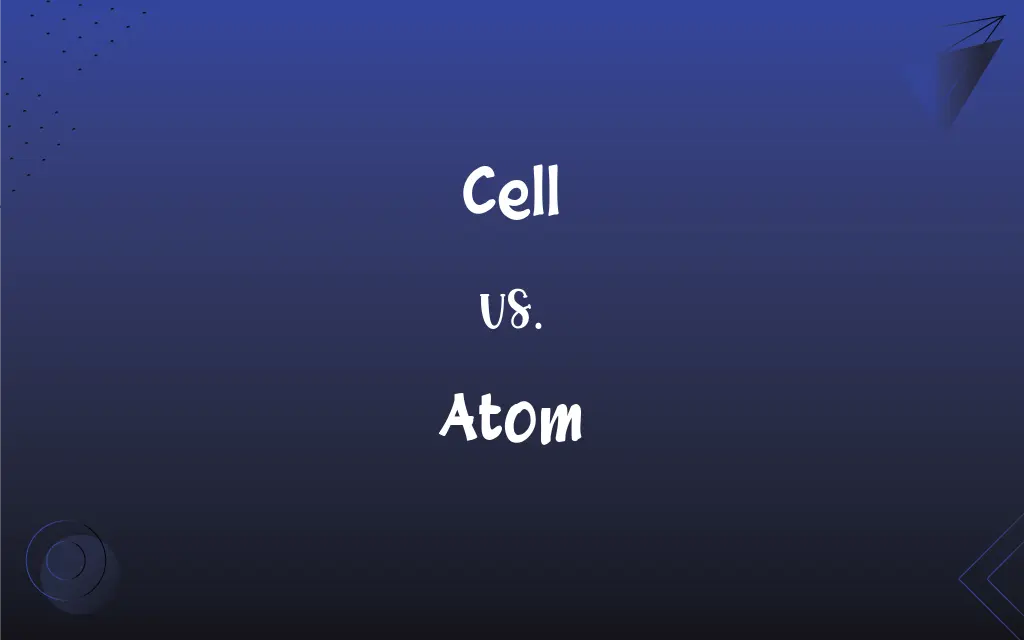Cell vs. Atom: What's the Difference?
Edited by Aimie Carlson || By Janet White || Published on December 19, 2023
A cell is the basic unit of life in organisms, while an atom is the smallest unit of a chemical element, fundamental in physics and chemistry.

Key Differences
A cell is the fundamental structural and functional unit of all living organisms, capable of self-replication. An atom, on the other hand, is the smallest unit of a chemical element, retaining its chemical properties.
Cells form the basis of biological structures and processes, including reproduction, energy conversion, and growth. Atoms, in contrast, are the building blocks of matter, forming molecules and compounds.
In terms of complexity, cells are composed of various molecules and organelles, each with specific functions. Atoms consist of a nucleus surrounded by electrons, simpler in structure.
The study of cells, cytology, is central to biology and medicine, focusing on living processes. Atomic theory and physics explore the properties and behaviors of atoms, fundamental to understanding the material world.
Cells interact in complex ways to form tissues and organs in multicellular organisms. Atoms interact primarily through chemical bonds, influencing the physical and chemical properties of substances.
ADVERTISEMENT
Comparison Chart
Basic Definition
Basic unit of life in organisms
Smallest unit of a chemical element
Role
Functional unit in biological processes
Building block of matter
Complexity
Composed of various molecules and organelles
Consists of a nucleus and electrons
Field of Study
Cytology, central to biology and medicine
Atomic theory, fundamental in physics
Interaction
Forms tissues and organs in multicellular life
Forms molecules and compounds through bonds
ADVERTISEMENT
Cell and Atom Definitions
Cell
Cells are building blocks of tissues in multicellular organisms.
Muscle tissues are made up of muscle cells.
Atom
An atom is the smallest unit of a chemical element.
A water molecule consists of hydrogen and oxygen atoms.
Cell
A cell is a basic unit of life in living organisms.
Human skin is composed of millions of cells.
Atom
Atoms bond to form molecules.
Carbon atoms bond together to form diamond.
Cell
It's the smallest entity that can exist as an independent life form.
Bacterial cells can live independently.
Atom
They retain the chemical properties of their element.
Gold atoms give gold its distinctive properties.
Cell
They carry genetic material and can replicate.
Cells divide during the process of mitosis.
Atom
Atoms participate in chemical reactions.
In photosynthesis, carbon dioxide atoms are used to create glucose.
Cell
Cells convert nutrients into energy.
Plant cells convert sunlight into energy through photosynthesis.
Atom
It's composed of a nucleus and electrons.
The hydrogen atom has one electron orbiting its nucleus.
Cell
A narrow confining room, as in a prison or convent.
Atom
A part or particle considered to be an irreducible constituent of a specified system.
Cell
A small enclosed cavity or space, such as a compartment in a honeycomb or within a plant ovary or an area bordered by veins in an insect's wing.
Atom
The irreducible, indestructible material unit postulated by ancient atomism.
FAQs
What is a cell?
The basic structural unit of life in organisms.
How do cells reproduce?
Most cells reproduce through mitosis.
What makes up an atom?
Nucleus and electrons.
What is an atom?
The smallest unit of a chemical element.
Are cells visible to the naked eye?
Most cells are microscopic.
Can atoms be seen with regular microscopes?
Atoms are too small to be seen with optical microscopes.
What is the role of atoms in matter?
Atoms make up all forms of matter.
What functions do cells perform?
They perform various life processes like energy conversion.
How do cells communicate?
Through chemical signals and physical contact.
Do cells have a lifespan?
Yes, cells have varying lifespans.
Are all cells the same size?
No, cell sizes vary widely.
Do all atoms have the same structure?
No, atomic structure varies by element.
Can atoms change their properties?
Yes, under chemical reactions.
What are isotopes?
Variants of elements with different numbers of neutrons.
What is atomic mass?
The mass of an atom of a chemical element.
Are atoms indestructible?
No, they can be split in nuclear reactions.
What is the significance of atomic theory?
It explains the nature and behavior of matter.
What types of cells exist?
There are prokaryotic and eukaryotic cells.
Can cells function independently?
Some cells, like bacteria, can.
What is cell theory?
A fundamental concept that all living things are composed of cells.
About Author
Written by
Janet WhiteJanet White has been an esteemed writer and blogger for Difference Wiki. Holding a Master's degree in Science and Medical Journalism from the prestigious Boston University, she has consistently demonstrated her expertise and passion for her field. When she's not immersed in her work, Janet relishes her time exercising, delving into a good book, and cherishing moments with friends and family.
Edited by
Aimie CarlsonAimie Carlson, holding a master's degree in English literature, is a fervent English language enthusiast. She lends her writing talents to Difference Wiki, a prominent website that specializes in comparisons, offering readers insightful analyses that both captivate and inform.








































































